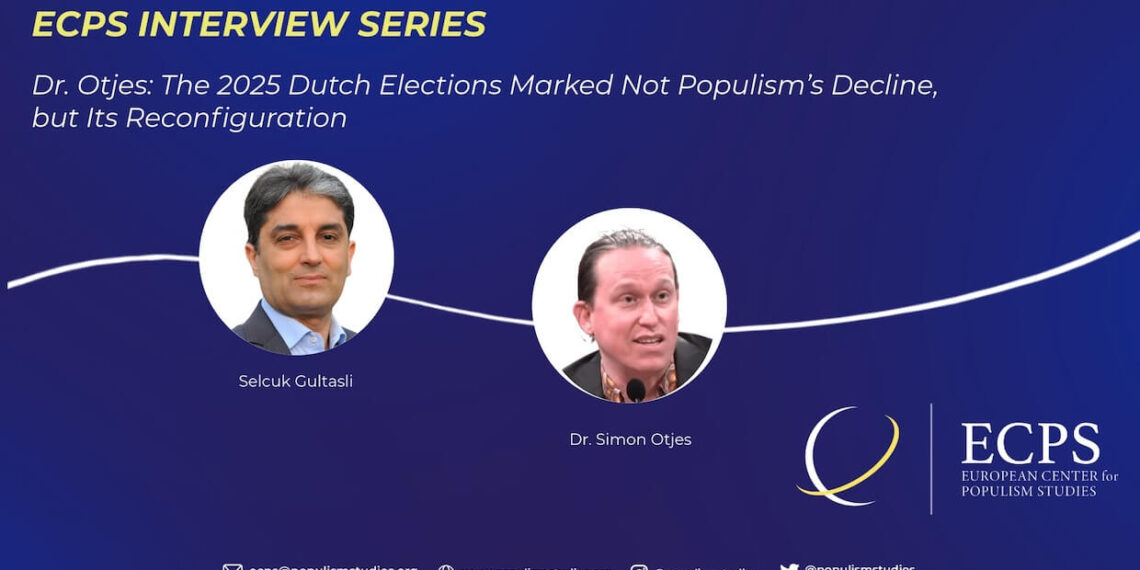In an in-depth interview with the ECPS, Dr. Simon P. Otjes, Assistant Professor of Dutch Politics at Leiden University, argues that the 2025 Dutch elections signaled not the decline but the reconfiguration of populism. “What was previously very strongly concentrated on the PVV has now dissipated into three different parties, representing three different ways of doing politics,” he notes. While JA21 seeks governmental influence and FvD appeals to conspiratorial electorates, the overall radical-right bloc remains stable. Dr. Otjes warns that a broad centrist coalition could “reproduce the very disaffection it seeks to contain,” fueling further populist resurgence. Far from a post-populist era, he concludes, “we’re still very much inside this populist moment.”
Interview by Selcuk Gultasli
In a wide-ranging interview with the European Center for Populism Studies (ECPS), Dr. Simon Otjes, Assistant Professor of Dutch Politics at Leiden University, offers a penetrating analysis of the evolving dynamics of populism, centrism, and democratic governance in the Netherlands and Europe. His reflections, delivered in the aftermath of the 2025 Dutch elections on October 29, illuminate the cyclical nature of populist mobilization and the institutional resilience of liberal democracy in an era of fragmentation and recalibration.
For Dr. Otjes, the Dutch political landscape exemplifies a persistent alternation between “almost technocratic, centrist governments… being interrupted by brief periods of radical right-wing governments,” a pattern visible over the past three decades. He observes that while populist radical-right parties such as PVV, JA21, and FvD have become structurally entrenched, their participation in government remains precarious and short-lived. “Populists enter government, those governments prove to be unstable, and then there’s a response from the center,” he notes, emphasizing that this oscillation does not represent a post-populist phase but rather “an enduring populist moment.”
The 2025 elections, in Dr. Otjes’s view, marked not the decline but the reconfiguration of populism. “What was previously very strongly concentrated on the PVV has now dissipated into three different parties, representing three different ways of doing politics,” he explains. While JA21 seeks policy influence within coalition frameworks, FvD appeals to conspiratorial electorates “in news environments very different from the mainstream media.” This diversification, Dr. Otjes warns, “is the key explanation of why [the radical right] remains so stable—their ability to attract very different electorates by diversifying their offerings.”
At the same time, Dr. Otjes cautions that a centrist grand coalition—combining GroenLinks–PvdA, D66, VVD, and CDA—could inadvertently deepen democratic alienation. Such an arrangement, he argues, would lead to “quite centrist compromises that lack the change these parties promised,” thereby driving dissatisfied voters back to the populist right. While this centrist stability may project pragmatism, it risks “reproducing the very disaffection it seeks to contain.”
On the European front, Dr. Otjes underscores that despite D66’s pro-European rhetoric under Rob Jetten, Dutch European policy is unlikely to shift dramatically. “The Netherlands won’t necessarily be a particularly progressive government on this issue,” he remarks, given the enduring influence of conservative fiscal and migration stances within the coalition.
Ultimately, Dr. Otjes’s analysis situates the Netherlands within a broader European pattern: an ongoing alternation between pragmatic centrism and reactive populism, rather than a linear progression beyond it. In his words, “We’re still very much inside this populist moment.”


